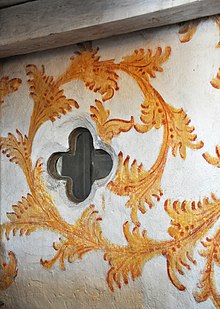Inclusion
Inclusions (of Latin inclusus "Locked-in") were able to be of prayer and asceticism dominated life in a Inklusorium include. Due to their extreme aversion to the world with the aim of achieving perfection (perfectio) , inclusions enjoyed a high spiritual reputation , especially in the European Middle Ages . In their ascetic principle they correspond to the early Christian pillar saints of the Middle East.
In the Romance-speaking area , the inclusions were mostly referred to as reclusus (Latin reclusus with an identical translation). In early Christianity in Egypt no cells of inclusions are known, in Nubia only inclusions were found in Sayala .
Inclusion
The inclusory is a cell or a small house, which is then also called a hermitage . The inclusory should be attached to a church so that the incluse can look at the altar through a hagioscope and follow the Holy Mass as well as receive communion and confess . The glass of the window is opaque or the window is covered with a curtain so that the inclusions cannot be seen from the outside. On the opposite side there should be a second window through which the inclusion receives light, air and essentials or can keep in contact with those seeking advice. In the early days the inclusions were unheated. From the 13th and 14th centuries, the regulations were gradually relaxed: Inclusions were allowed to be heated, but in many inclusions there was no way to do so due to the way they were built.
In the past, inclusions were mostly in monasteries . Later it was also clerics or wealthy families who founded a hermitage or took care of its maintenance.
Well-known female inclusions
- St. Verena (around 260-320), in Bad Zurzach , Switzerland
- Liutbirg († around 870)
- Wiborada († around 926 in St. Gallen ), martyr
- St. Aurelia of Regensburg († 1027 in Regensburg )
- Jutta von Sponheim (around 1092–1136) Incluse on the Disibodenberg, teacher of St. Hildegard
- St. Hildegard von Bingen (1098–1179) lived as an inclusive for several years in her youth
- St. Ida of Toggenburg (around 1140-1226)
- Eva von Lüttich (around 1190–1265)
- Juliana of Norwich (around 1342 - after 1413)
- St. Dorothea von Montau (1347–1394), inclusiveness at Marienwerder Cathedral in West Prussia
- Elisabeth von Beutnitz (1402–1445), in Beutnitz , Thuringia
- Sel. Rosa Flesch (1826–1906) lived temporarily as an inclusion in the Kreuzkapelle on the Wied
Known male inclusions
- Schio, one of the "13 Syrian fathers", who had himself walled up in the middle of the 6th century in the Schiomghwime cave monastery in Georgia, which he founded
- Fintan von Rheinau (around 803–878), Irish hermit
- Simeon von Trier (around 980 / 990–1035), Byzantine monk in Sicily
- Amnichad von Fulda († 1043), Irish hermit
- Mercherdach , Irish monk in the 11th century
See also
literature
- Tom License: Hermits and Recluses in English Society, 950-1200. Oxford University Press, Oxford 2011, ISBN 978-0199592364
Web links
- Michael Buhlmann: Inclusions in the Amtenhausen Monastery . (Examples of female-religious life in the high Middle Ages)
Individual evidence
- ^ Peter Grossmann: Christian architecture in Egypt. (Handbook of Oriental Studies. Section One: The Near and Middle East. Volume 62) Brill, Leiden 2002, p. 258
